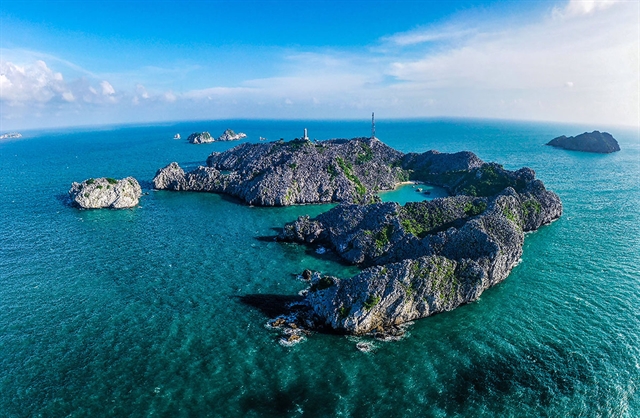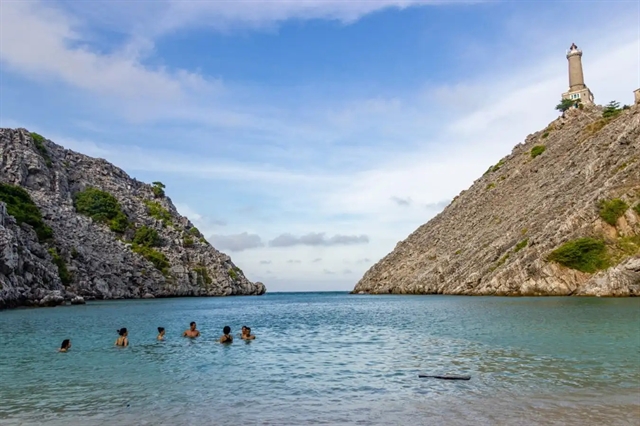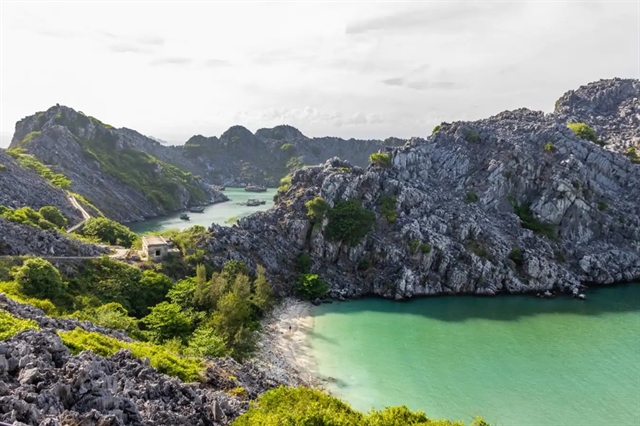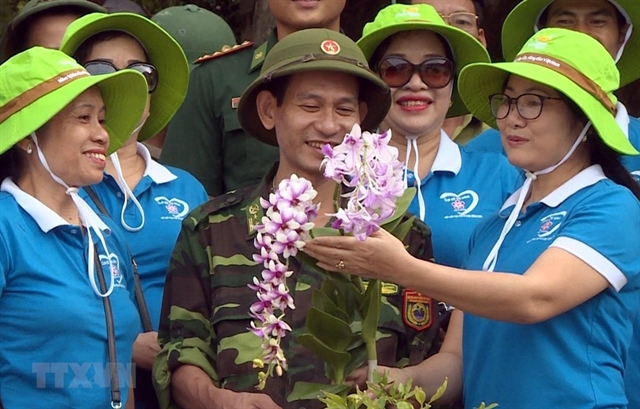 Sunday/Weekend
Sunday/Weekend

 |
| The Long Châu Lighthouse stands at a height of 110m above sea level. — Photo vovlive.vn |
By Thanh Nga
Hải Phòng tourism has captivated visitors with its myriad interesting destinations and rich cuisine. The Long Châu archipelago is an ideal spot for those who are looking for a new place to travel and experience when visiting the northern port city.
The archipelago is located in Cát Hải District, approximately 50km from the coast of Hải Phòng port city. It is very well known because it is home to a lighthouse built more than 100 years ago.
 |
| Long Châu Islands seen from above. — Photo vovlive.vn |
The archipelago is composed of more than 30 limestone islets and reefs. It features sharp, pointed rocks amid the deep blue skies and seas.
The almost bare islands are uninhabited; there are only a team of men guarding the lighthouse, which allows this rocky outpost to retain its inherent wildness and majestic beauty bestowed by nature.
 |
| The beach is located deep in the bay, resulting in calm and gentle waves. It is suitable for swimming. — Photo traveloka.com |
It is necessary to obtain permission from the Long Châu Border Guard Station to visit the islands.
From central Hải Phòng City, one can travel to Bèo Wharf, Cát Hải District, to rent a boat to the islands. Each boat can carry about 10 people, and the average rental price is from VNĐ400,000 - VNĐ600,000 per boat.
Sitting on the boat, inhaling the sea breeze, and gazing at the towering rocky mountains in the vast ocean, one can truly relax and experience a sense of peace.
During the journey, we passed through an intriguing area called Lan Hạ Bay, a calm, arc-shaped bay with a shimmering strip of water divided by large and small limestone islands, creating a breathtaking natural scene.
The islands finally come into view after about 30 minutes. In the middle of the vast ocean, a tall mountain stands proudly with a lighthouse, as if challenging the test of time.
Upon arrival, we headed to a clear blue beach right at the foot of the lighthouse. This quiet space belonged solely to our group, the vast skies and cool blue seas. It exceeded our expectations and provided a rich experience.
The beach is located deep in the bay, resulting in calm and gentle waves. It is not very deep, making it perfect for swimming. There were only a few people on the large, white beach with clear blue water. We could freely lie on the sandy shore, gaze at the skies and relax without being bothered by anyone.
After enjoying our swim, we took a leisurely walk around the islands and visited the stone lighthouse, built in 1894 during the French colonial era.
 |
| A corner of Long Châu Islands. — Photo traveloka.com |
Long Châu Lighthouse stands at an impressive height of 110m above sea level. It is one of the three oldest lighthouses in Việt Nam, along with Hòn Dấu also in Hải Phòng, and Kê Gà in the central province of Phan Thiết.
From a distance, we immediately spot the lighthouse tower with a distinctive dome rising skywards. Its strong light reaching up to 27 nautical miles away warns and guides ships and boats arriving and departing from Hải Phòng Port. The lighthouse is also known as the "Long Châu pearl eye" by seafarers.
Standing on the windy lighthouse and gazing into the distance, we could see the sharp and jagged rock formations. Further off, Lan Hạ Bay unfolded before us, showcasing the majestic beauty of the seas, skies, and limestone isles amid the emerald green waters.
We had a cheery chat with some border guards stationed on Long Châu, who were happy to tell us about the history of the place. The soldiers spend most of their time on the island, only visiting home once a year. Long Châu is their home.
Mai Tiến Mạnh, a native of Hải Phòng's outlying district of Tiên Lãng, has been assigned to work at Long Châu Lighthouse since January last year. He is in charge of maintaining equipment, lights, machines, and observing the sea for any incidents during the day. At night, they turn on the lights to warn and guide sea craft.
The most enduring challenge for those on the islands is the lack of fresh water. There is no underground water source, so they rely mainly on rainwater kept in tanks and water transported from the mainland.
 |
| Hải Phòng residents present orchids to border guards at Long Châu Islands. VNA/VNS Photo |
The soldiers' efforts and dedication to protecting the lighthouse are supported by fishermen in surrounding areas.
Phạm Văn Dũng from Cát Bà Town, who has been working as a fisherman since 2012, said that seeing the lighthouse during the day and its lights at night brought a sense of comfort to those at work at sea.
When the staff at Long Châu Lighthouse have urgent duties on the mainland, Dũng and other fishermen are willing to temporarily leave their own work to provide support.
After our visit to the lighthouse, we returned to a raft house moored around the islands, where we had arranged to stay overnight.
This particular raft house specialises in catching and selling seafood such as shrimp, crabs, squid, snails, and oysters.
Whatever we wanted to eat, we could get directly from the raft house, and the owner cooked them into delicious dishes. In just a few minutes, we found ourselves enjoying a hearty party, full of sea food, iced beer, and more important, laughter. VNS




